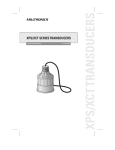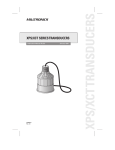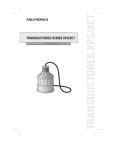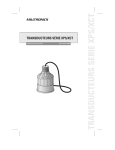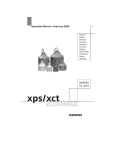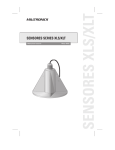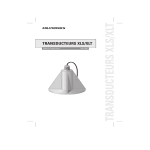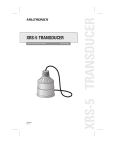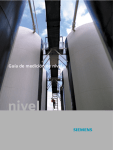Download Siemens XPS15F Instruction manual
Transcript
Instruction Manual December 2001 XPS/XCTTRANSDUCERS XPS/XCT SERIESTRANSDUCERS Safety Guidelines Warning notices must be observed to ensure personal safety as well as that of others, and to protect the product and the connected equipment. These warning notices are accompanied by a clarification of the level of caution to be observed. Qualified Personnel This device/system may only be set up and operated in conjunction with this manual. Qualified personnel are only authorized to install and operate this equipment in accordance with established safety practices and standards. Warning: This product can only function properly and safely if it is correctly transported, stored, installed, set up, operated, and maintained. Note: Always use product in accordance with specifications. Copyright Siemens Milltronics Process Instruments Inc. 2001. All Rights Reserved Disclaimer of Liability This document is available in bound version and in electronic version. We encourage users to purchase authorized bound manuals, or to view electronic versions as designed and authored by Siemens Milltronics Process Instruments Inc. Siemens Milltronics Process Instruments Inc. will not be responsible for the contents of partial or whole reproductions of either bound or electronic versions. While we have verified the contents of this manual for agreement with the instrumentation described, variations remain possible. Thus we cannot guarantee full agreement. The contents of this manual are regularly reviewed and corrections are included in subsequent editions. We welcome all suggestions for improvement. Technical data subject to change. MILLTRONICS®is a registered trademark of Siemens Milltronics Process Instruments Inc. Contact SMPI Technical Publications at the following address: Technical Publications Siemens Milltronics Process Instruments Inc. 1954 Technology Drive, P.O. Box 4225 Peterborough, Ontario, Canada, K9J 7B1 Email: [email protected] For the library of SMPI instruction manuals, visit our Web site: www.milltronics.com © Siemens Milltronics Process Instruments Inc. 2001 ABOUT THE TRANSDUCER The Echomax XPS / XCT series of transducers operates in association with Milltronics ultrasonic level monitoring products. transducer The transducer converts the electrical energy of the transmit pulse from the transceiver into acoustical energy. It then converts the acoustical energy of the echo back into electrical energy for the transceiver receive period. transducer face – 3 db boundary The effective acoustical energy is emitted from axis of the transducer face and radiated outward, transmission, decreasing in amplitude at a rate inversely perpendicular to proportional to the square of the distance. transducer face Maximum power is radiated axially (perpendicular) from the transducer face in a line referred to as the axis of transmission. Where power is reduced by half (– 3 dB), a conical boundary defining the sound beam, centered about the axis of transmission, is established. The diametric measurement of the cone in degrees defines the beam angle. Impedance matching techniques are used to optimize the transfer of power from the transducer into air and vice versa. The XPS / XCT transducers incorporate an integral temperature sensor that reports the air temperature at the transducer to the transceiver. The connection is transparent, in that both the ultrasonic and temperature components of the transducer use the same leads. GENERAL GUIDELINES XPS/XCT Series - Certificate SIRA 99ATEX5153X This equipment may be used in hazardous areas associated with all gases with temperature classes T1, T2, T3 and T4 for the XPS series (XPS-10, XPS-15, XPS-30 and XPS-40) and T1, T2 and T3 for the XCT series (XCT-8 and XCT-12). The XPS series is only certified for use in ambient temperatures in the range of - 40°C to 95°C and the XCT series is only certified for use in ambient temperatures in the range of -40°C to 145°C. Neither should be used outside of their respective temperature ranges. Installation shall be carried out in accordance with the applicable code of practice, and by suitably trained personnel. These devices should only be supplied from a circuit containing a suitably-rated fuse that has a breaking capacity of 4000A. This fuse is included in Siemens Milltronics’ transceivers. Repair of this equipment shall be carried out in accordance with the applicable code of practice. The certification of this equipment relies on the following materials used in their construction: Material XPS Series Enclosure Kynar 710 XCT Series Kynar 710 Encapsulant LA-9823-76 Durapot 861-F3 & 864 Manual override can be accomplished by using the disconnect switch provided in the building installation of the associated controller. 7ML19981AK01.2 XPS/XCT Transducers 3 XPS D Series - Certificate SIRA 01ATEX5262X This equipment may be used in all hazardous dust zones with all conductive and non-conductive dusts. The Type XPS-10D, XPS-15D, XPS-30D and XPS-40D Series transducers have a maximum surface temperature of 135°C (275°F) (Temperature Class T4). These units are certified for use in ambient range of -40 to 95°C (-40 to 203°F). The transducers should not be used outside this temperature range. The XPS-10D, XPS-15D, XPS-30D and XPS-40D Ultrasonic Transducers must be installed so the face of the transducer is not substantially subjected to light. Installation shall be carried out in accordance with the applicable code of practice, and by suitably trained personnel. These devices should only be supplied from a circuit containing a suitably rated fuse that has a breaking capacity of 4000A. This fuse is included in Siemens Milltronics transceivers. Repair of the equipment shall be carried out in accordance with the applicable code of practice and Installation Instructions. The certification of this equipment relies on the following materials used in their construction: Enclosure Kynar complete with carbon nanotube (Polyvinylidene Flouride (PVDF) with carbon nanotube [RTP Part No. 3399 X 93208 E]). Encapsulant Stycast LA-9823-76 or Durapot 864 (as appropriate) Manual override can be accomplished by using the disconnect switch provided in the building installation of the associated controller. XPS D Series Product Marking PETERBOROUGH, CANADA XPS-xxD ULTRASONIC TRANSDUCER SERIAL No.: V IN : 1.77 V r.m.s.; 250 Vp I IN : 44.2 mA r.m.s. AMBIENT TEMP.: –40 C TO 95 C. EEx m I I T4 SIEMENS MILLTRONICS PROCESS INSTRUMENTS INC. PETERBOROUGH 4 II 2G 1D T4 II 2GD T4 0518 SIRA 01ATEX5262X SEE INSTRUCTION MANUAL FOR OPERATION. XPS/XCT Transducers 7ML19981AK01.2 SPECIFICATIONS Model : XPS - 10 XPS - 15 XPS - 30 XPS - 40 XCT - 8 XCT - 12 Measurement Range, 0.3 - 10 0.3 - 15 0.6 - 30 0.9 - 40 0.6 - 8 0.6 - 12 (1-33) (1-50) (2-100) (3-130) (2-26) (2-40) Frequency (kHz): m (ft): 43 43 30 22 43 43 Beam Angle: 12° 6° 6° 6° 12° 6° Environmental: -location: indoor / outdoor -altitude: 2000 m maximum -ambient temperature: -40 to 95 °C (-40 to 203 °F) -pollution degree: -40 to 145 °C (-40 to 293 °F) 4 Construction: -exposure: Kynar® -mounting: 1" NPT or BSP conduit connection Standard: Kynar® Optional: Universal1 sized flange available with Teflon® facing 1-1/2” NPT or BSP conduit connection 1” NPT or BSP conduit connection -options: » factory bonded to suit ANSI, DIN and JIS standards » polyethylene foam facing for dusty or steamy environments » submergence shield, where flooding can occur (only available for XPS-10, XPS-15) » split flange for field mounting to suit ANSI, DIN and JIS standards (not available for XPS-40) Included: 2-wire twisted pair / braided and foil shielded, 0.5mm² (20 AWG), PVC jacket 2-wire twisted pair / braided and foil shielded, 0.5mm² (20 AWG), PVC jacket Maximum separation: 100 m (330 ft) -cable: Silicone jacket RG-62 A/U coax Maximum separation: 365 m (1200 ft) Supply Source: Weight*, kg (lb): Separation: Approvals: transducer shall only be supplied by Milltronics certified controllers 0.8 (1.7) 1.3 (2.8) 4.3 (9.5) 8 (18) 0.8 (1.7) 1.3 (2.8) 365 m (1200 ft) from transducer CE **, CSA, FM, CENELEC/ATEX see nameplate or consult Milltronics for current approvals * approximate shipping weight of transducer with standard cable length ** EMC performance available upon request 1. Universal flange fits ANSI, DIN, and JIS standards. Kynar® is registered trademark of ELF Atochem Teflon® is a registered trademark of DuPont 7ML19981AK01.2 XPS/XCT Transducers 5 OUTLINE AND DIMENSIONS radiating face optional bonded flange standard refer to associated instructions optional split flange refer to associated instructions optional submergence shield refer to associated instructions Model Dimension XPS - 10 XPS - 15 XPS - 30 XPS - 40 XCT - 8 A 86 mm (3.4") 119 mm (4.7") 173 mm (6.8") 206 mm (8.1") 86 mm (3.4") XCT - 12 119 mm (4.7") B 122 mm (4.8") 132 mm (5.2") 198 mm (7.8") 229 mm (9.0") 122 mm (4.8") 132 mm (5.2") C to suit ANSI, DIN and JIS standards D* 128 mm (5.0") 138 mm (5.4") 204 mm (8.0") 235 mm (9.2") 128 mm (5.0") 138 mm (5.4") E 124 mm (4.9") 158 mm (6.2") n/a n/a n/a n/a F 152 mm (6.0") 198 mm (7.8") n/a n/a n/a n/a * nominal 6 XPS/XCT Transducers 7ML19981AK01.2 MOUNTING DO’S AND DON’TS Special handling precautions must be taken to protect the face of the transducer from any damage. Mount the transducer so that it is above the maximum material level by at least the blanking value. Refer to the associated transceiver manual. On liquid applications, the transducer must be mounted so that the axis of transmission is perpendicular to the liquid surface. On solids applications, a Milltronics Easy Aimer should be used to facilitate aiming of the transducer. Do not overtighten mounting. Hand tightening of the mounting hardware is sufficient. Secure installation by connecting a safety chain from the transducer to a structural member. Consider the optional temperature sensor when mounting the transducer. MOUNTING - SOLIDS APPLICATIONS Easy Aimer (typical model) safety chain transducer 7ML19981AK01.2 XPS/XCT Transducers 7 MOUNTING - LIQUID APPLICATIONS Bracket Flexible Conduit flexible conduit steel channel coupling safety chain transducer Flexible conduit mounted transducer should not be subjected to wind, vibration or jarring. Plywood Submersible rigid metal conduit coupling safety chain submergence shield Submersible transducer, used in applications where flooding is possible. 8 Plywood mounting provides excellent isolation, but must be rigid enough to avoid flexing if subjected to loading. XPS/XCT Transducers 7ML19981AK01.2 MOUNTING - LIQUID APPLICATIONS (cont’d) Blind Flange nipple welded to blind flange coupling Flange, gasket and hardware supplied by customer. Refer to Liquid \ Applications - Standpipes. Note: Tighten the flange bolts evenly in order to ensure a good seal between the mating flanges. Caution: Overtightening can cause performance degradation. Flanged coupling factory flanged transducer bolt gasket customer flange, flat face only nut Customer flanged standpipe. If a metal flange must be welded to pipe, refer to Liquid \ Applications - Standpipes. 7ML19981AK01.2 XPS/XCT Transducers 9 INTERCONNECTION Milltronics transceiver ( typical ) Direct Connection For EnviroRanger ERS 500 only, connect all three wires separately. blk wht drain / shield 2 Wire Extension wht For EnviroRanger ERS 500 only, connect all three wires separately. blk junction box drain / shield extend cable using 18 AWG shielded / twisted pair Coaxial Extension When connecting to an EnviroRanger ERS 500, do NOT use coaxial cable, use a 2-wire extension as illustrated above. extend cable using RG - 62 A/U coax for optimum noise immunity 10 XPS/XCT Transducers 7ML19981AK01.2 DO’S AND DON’TS Installation shall only be performed by qualified personnel and in accordance with local governing regulations. Do not route cable openly. For optimum isolation against electrical noise, run cable separately in a grounded metal conduit. Seal all thread connections to prevent ingress of moisture. Do not run cable near high voltage or current runs, contactors and SCR control drives. 7ML19981AK01.2 XPS/XCT Transducers 11 APPLICATIONS The transducer is to be used only in the manner outlined in this instruction manual. Normally, the transducer requires no cleaning or maintenance. However, if performance changes are observed, immediately shut down the level measurement system and perform a thorough inspection, especially on the transducer. LIQUID APPLICATIONS - STILLING WELL / OCM blind flange air vent TS-3 * transducer standpipe bracing standpipe inlet primary element stilling well stilling well inlet Refer to Liquid \ Applications - Standpipes. * the use of a TS-3 temperature sensor provides better temperature tracking in applications where the temperature can change quickly. 12 XPS/XCT Transducers 7ML19981AK01.2 LIQUID APPLICATIONS - SUBMERGENCE In applications where flooding is possible the transducer▼ can be fitted with a submergence shield. The shield acts as a bell to create an air pocket in front of the transducer face. The associated transceiver▼ interprets this as a flooding condition, and reacts accordingly. Refer to transceiver manual for programming requirements. transducer submergence shield * air pocket * refer to associated instruction manual for assembly details. ▼ on applicable models. 7ML19981AK01.2 XPS/XCT Transducers 13 LIQUID APPLICATIONS - STANDPIPES In many applications access must be made via a standpipe. In such cases, Milltronics can provide factory bonded flanged transducers or split flange kit that will readily mate to the flanged standpipe. Another option is to hang the transducer from a blind flange. The standpipe length should be as short and the diameter as large as possible. As a rule of thumb, the -3 dB cone of the sound beam should not intersect the standpipe wall in applications opening into a vessel or larger area. Otherwise, additional blanking will be required to compensate for the interference zone created by the opening. Note: When using a stilling well, make sure there is no build-up, welds, couplings, or other debris on the inside of the well wall. This can affect reliability of level measurement. flanged transducer no vessel no intersection vessel no additional blanking required no additional blanking required nipple welded into blind flange nipple welded into a blind flange transducer transducer transducer can read level inside or below standpipe sound beam intersects vessel standpipe end cut on a 45 ° angle typically near blanking extension of 150 mm (6") past end of standpipe may be required. no additional blanking required 14 reflection at interference zone created by opening XPS/XCT Transducers 7ML19981AK01.2 LIQUID APPLICATIONS - VOLUME ‘ Alternate ’ ‘ Preferred ’ ‘ Bad ’ tank manufacturer’s full level Maintain full level for full calibration. Above this level erroneous readings will result as level has entered blanking zone. (shaded area) beam angle span : corresponds to tank manufacturer’s empty level. rise Empty level for ‘alternate’ location. Below this level, echo would reflect away from the transducer. may require target to obtain empty reading tank manufacturer’s empty level discharge 1. Beam should not detect bin bottom. If this occurs use range extension parameters (on transceivers where available) to omit false echoes. A 6° beam angle represents a rise : run of about 20 : 1 (10 : 1 for 12°). In most tanks, the transducer should be centered as much as possible (without interference from inlet) for optimum reading range. 2. Sound beam must be perpendicular to liquid surface. If standpipe is used, refer to Liquid / Applications - Standpipes. 3. Echo has missed improperly leveled transducer. 4. When performing an empty or full calibration, the tank must contain its normal vapour and be at its normal temperature. 7ML19981AK01.2 XPS/XCT Transducers 15 LIQUID APPLICATIONS - WATER / WASTEWATER DIFFERENTIAL LEVEL PUMP CONTROL 16 XPS/XCT Transducers SEWAGE LIFT 7ML19981AK01.2 SOLIDS APPLICATIONS - TYPICAL Easy Aimer 1 bin wall seams 3 2 filling profile emptying profile 1. Transducer angled to avoid seams in bin wall and aimed at discharge in order to read bin when empty. 3. Transducer too close to material inlet. Falling material will intersect sound beam and cause erroneous readings or loss of echo. 2. Avoid intersecting bin wall seams, structural members and wall irregularities. Otherwise, transducer minimal angle of repose 5 4 discharge 5. On dual discharge bins, aim each transducer at the discharge point. 4. On fluid like solids, aim transducer perpendicular to material surface. 7ML19981AK01.2 XPS/XCT Transducers 17 SOLIDS APPLICATIONS - SPECIAL STORAGE BIN WITH AGITATOR infeed agitator 1. Transducer should be kept away from infeed. 2. Where agitators are in use, use the Agitator Discrimination parameter on transceivers where available. 3. Transducer should be aimed away from wall projections. DRYER - WOOD CHIPS infeed drag conveyor typical low level typical high level 1. Transducer should be mounted perpendicular to slope of wood chips. 18 XPS/XCT Transducers 7ML19981AK01.2 INSTALLATION DIAGRAM See Milltronics drawing number 0-9650017Z-DI-A for current drawing status. 7ML19981AK01.2 XPS/XCT Transducers 19 FOR CANADIAN HAZARDOUS INSTALLATIONS ONLY See Milltronics drawing number 0-8850004Z-DI-A for current drawing status. 20 XPS/XCT Transducers 7ML19981AK01.2 Notes.fm Page 2 Thursday, October 11, 2001 8:48 AM Notes Notes.fm Page 1 Thursday, October 11, 2001 8:48 AM Notes IQ300IX.fm Page 5 Tuesday, October 2, 2001 1:43 PM 1 *7ml19981ak01*
























